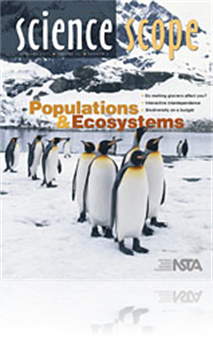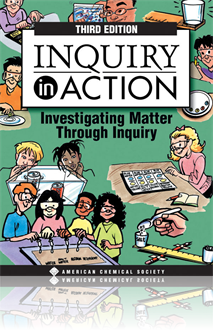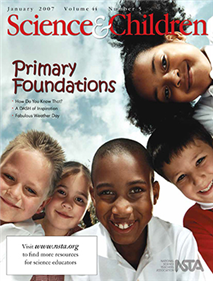All Resources
Journal Article
Science Sampler: The biological budget
Students often have difficulty grasping the complexity of ecosystems and the importance of biodiversity. The following activity applies students’ creativity and basic math skills to creating a sustainable and diverse food web. The biological budget...
Journal Article
Incorporating Amphibian Malformation into Inquiry-Based Learning
Since the first discovery of malformed frogs by an adventurous middle school teacher and her after-school science club in 1995, outreach programs like A Thousand Friends of Frogs (see Resources) have been created to connect students and teachers with...
Acquired Book
Inquiry in Action, Third Edition
Inquiry in Action provides a selection of activities that will help to enhance your physical science curriculum. This guide includes valuable tips on classroom instruction. As a resource, it also offers content-related material along with assessmen...
Book Chapter
The purpose of this assessment probe is to elicit students’ ideas about intensive and extensive properties of matter. The probe is designed to find out which properties students think will change if the amount of material changes and which will sta...
Book Chapter
The purpose of this assessment probe is to elicit students’ ideas about the transfer of energy. The probe is designed to determine whether students recognize that heat flows from warmer objects or areas to cooler ones. ...
Book Chapter
The purpose of this assessment probe is to elicit students’ ideas about adaptation. The probe is designed to reveal whether students think individuals intentionally change their physical characteristics or behaviors in response to an environmental ...
Book Chapter
The purpose of this assessment probe is to elicit students’ ideas about density. The probe is designed to find out if students think changing the size of an object affects its density....
Book Chapter
The purpose of this probe is to elicit students’ ideas about the day/night cycle. The probe is designed to find out if students recognize that the Earth’s rotation is responsible for the day/night cycle. ...
Book Chapter
The purpose of this assessment probe is to elicit students’ ideas about the relative position of common objects seen in the sky. The probe is designed to find out if students recognize how far away the stars are in relation to the Earth and the Moo...
Journal Article
Every Day Science Calendar—January 2007
This monthly feature contains facts and challenges for the science explorer....
Journal Article
Teaching through Trade Books: Rocking Around the Rock Cycle
“What type of rock is this?” is a common question spoken by all children at some point in their young lives. Many students have rocks of all shapes and sizes in their “collections.” In this column, young students will have the opportunity to ...
Journal Article
Favorite Demonstration: E-Concept Mapping
Not all demonstrations involve using exciting visual displays of one or a series of scientific principles. Demonstrations can be as simple as showing the interrelationship between scientific concepts or principles using concept maps. Concepts maps ar...
Journal Article
Summarizing with Drawings: A Reading-Comprehension Strategy
The development of literacy skills is essential for student success. According to the National Science Education Standards, “Scientific literacy entails being able to read with understanding articles about science in the popular press and to engag...
Journal Article
Drawing on Students' Knowledge
Effective instruction requires continual assessment of student understanding to identify and redirect misconceptions. This is particularly important when dealing with topics that seem straightforward to the teacher but may go beyond the personal expe...
Journal Article
Science 101: What causes the seasons?
In this article, we learn about the relationship between the Earth and the sun at certain times of the year. Certain myths are broken, and we get a real lesson on what causes the seasons....
Journal Article
Each year, first graders at Kensington Parkwood Elementary School in Kensington, Maryland, look forward to Fabulous Weather Day. After studying weather for three months, we celebrate what we have learned and stretch our thinking further into the weat...
Journal Article
Core concepts can be integrated throughout lower-division science and engineering courses by using a series of related, cross-referenced laboratory experiments. Starting with butane combustion in chemistry, we expanded the underlying core concepts of...
Journal Article
After the Bell: Making a community information guide about nonpoint source pollution
A good slogan to introduce this project is “think globally, act locally.” The purpose of the project is to inform students that the actions they take at home may have a far-reaching effect. The assignment will help to create community awareness a...
Journal Article
Student interest in science has been amplified at one elementary school. During a recent unit on sound, students in a fourth-grade class participated in a series of dynamic sound learning centers followed by a dramatic capstone event— an exploratio...
Journal Article
Research and Teaching: Small-Group Peer Teaching in Introductory Biology Classroom
All teachers want their students to learn, enjoy, and be engaged in their classes. A good way to create such results is to incorporate active learning approaches into classrooms. Many teachers, however, do not know how to start making these changes a...
Journal Article
To adequately prepare future faculty for their multiple roles as researchers, teachers, and colleagues, innovative teaching opportunities must be made available to doctoral students that allow them to maintain a high level of research productivity ...
Journal Article
Using Science Fiction Movie Scenes to Support Critical Analysis of Science
This article discusses the pedagogical advantages and challenges of using science-fiction movies and television shows in an introductory science class for elementary teachers. Two instructional episodes are described in which scenes from the movies R...
Journal Article
Teacher’s Toolkit: Making the most of concept maps
A concept map is a two-dimensional, graphic or schematic diagram illustrating the interconnections, and often the hierarchy, of a particular concept or topic. Concept maps are especially important in teaching science because they depict the interrela...
Journal Article
Tabizi Pythons & Clendro Hawks: Using Imaginary Animals to Achieve Real Knowledge about Ecosystems
In the engaging unit described here, imaginary organisms are used to teach a variety of topics related to ecosystems—food chains and energy flow, food webs, limiting factors, carrying capacity, and the effects of natural and human-made events on ec...







